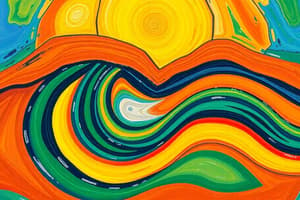Podcast
Questions and Answers
What is an earthquake?
What is an earthquake?
An earthquake is shaking of the Earth.
The release of energy during an earthquake occurs randomly and without pattern.
The release of energy during an earthquake occurs randomly and without pattern.
False (B)
What is the focus, or hypocentre, of an earthquake?
What is the focus, or hypocentre, of an earthquake?
The point where the energy is released.
What is the epicenter of an earthquake?
What is the epicenter of an earthquake?
Earthquake waves are only propagated through solid materials.
Earthquake waves are only propagated through solid materials.
How are earthquake waves recorded?
How are earthquake waves recorded?
What are the two basic types of earthquake waves?
What are the two basic types of earthquake waves?
Where are body waves generated?
Where are body waves generated?
Body waves are the slowest type of earthquake wave.
Body waves are the slowest type of earthquake wave.
What are the two types of body waves?
What are the two types of body waves?
P-waves move transversally.
P-waves move transversally.
What type of material can P-waves travel through?
What type of material can P-waves travel through?
What is one characteristic of S-waves?
What is one characteristic of S-waves?
The outer core of the Earth is in solid form.
The outer core of the Earth is in solid form.
Describe how S-waves propagate.
Describe how S-waves propagate.
When are surface waves generated during an earthquake?
When are surface waves generated during an earthquake?
Surface waves are not considered very damaging.
Surface waves are not considered very damaging.
Which of the following scenarios is LEAST likely to induce an earthquake?
Which of the following scenarios is LEAST likely to induce an earthquake?
If a seismograph station records the arrival of P-waves but no S-waves following a distant earthquake, what can be inferred about the intervening material between the earthquake's focus and the station?
If a seismograph station records the arrival of P-waves but no S-waves following a distant earthquake, what can be inferred about the intervening material between the earthquake's focus and the station?
Which statement accurately compares the characteristics of P-waves and S-waves?
Which statement accurately compares the characteristics of P-waves and S-waves?
How does the Richter scale quantify the magnitude of an earthquake?
How does the Richter scale quantify the magnitude of an earthquake?
What is the primary difference between the focus and the epicenter of an earthquake?
What is the primary difference between the focus and the epicenter of an earthquake?
How do Love waves differ from Rayleigh waves?
How do Love waves differ from Rayleigh waves?
How do tectonic plate boundaries contribute to the occurrence of earthquakes?
How do tectonic plate boundaries contribute to the occurrence of earthquakes?
What is the relationship between the magnitude of an earthquake and the amplitude of seismic waves it produces?
What is the relationship between the magnitude of an earthquake and the amplitude of seismic waves it produces?
Which of the following scenarios would most likely result in the generation of a tsunami?
Which of the following scenarios would most likely result in the generation of a tsunami?
How does the behavior of a tsunami change as it moves from deep ocean water to shallow coastal waters?
How does the behavior of a tsunami change as it moves from deep ocean water to shallow coastal waters?
Which of the following is the MOST important factor that contributes to the high concentration of earthquakes along the Pacific Ring of Fire?
Which of the following is the MOST important factor that contributes to the high concentration of earthquakes along the Pacific Ring of Fire?
Why can intraplate earthquakes be particularly dangerous, despite being less frequent than earthquakes at plate boundaries?
Why can intraplate earthquakes be particularly dangerous, despite being less frequent than earthquakes at plate boundaries?
A coastal city is located near a subduction zone known for generating large earthquakes. Which mitigation strategy would be MOST effective in reducing the potential impact of a future tsunami?
A coastal city is located near a subduction zone known for generating large earthquakes. Which mitigation strategy would be MOST effective in reducing the potential impact of a future tsunami?
Which of the following statements BEST describes the difference between the Mercalli scale and the moment magnitude scale?
Which of the following statements BEST describes the difference between the Mercalli scale and the moment magnitude scale?
What is the primary goal of earthquake early warning systems, and how do they achieve it?
What is the primary goal of earthquake early warning systems, and how do they achieve it?
What is the main purpose of implementing base isolation techniques in building construction, particularly in earthquake-prone regions?
What is the main purpose of implementing base isolation techniques in building construction, particularly in earthquake-prone regions?
Why is vertical displacement of the seafloor a critical factor in tsunami generation, as opposed to horizontal displacement?
Why is vertical displacement of the seafloor a critical factor in tsunami generation, as opposed to horizontal displacement?
Which of the following is an example of earthquake mitigation through retrofitting?
Which of the following is an example of earthquake mitigation through retrofitting?
Flashcards
Earthquake
Earthquake
Shaking of the Earth caused by a release of energy.
Earthquake Cause
Earthquake Cause
A natural event caused by the release of energy, generating waves.
Fault
Fault
A sharp break in crustal rocks where energy is released during an earthquake.
Focus/Hypocentre
Focus/Hypocentre
Signup and view all the flashcards
Epicenter
Epicenter
Signup and view all the flashcards
Earthquake Waves
Earthquake Waves
Signup and view all the flashcards
Seismograph
Seismograph
Signup and view all the flashcards
Body Waves
Body Waves
Signup and view all the flashcards
Surface Waves
Surface Waves
Signup and view all the flashcards
P-Waves (Primary)
P-Waves (Primary)
Signup and view all the flashcards
S-Waves (Secondary)
S-Waves (Secondary)
Signup and view all the flashcards
Transverse Wave Motion
Transverse Wave Motion
Signup and view all the flashcards
Longitudinal wave motion
Longitudinal wave motion
Signup and view all the flashcards
S-wave shadow zone
S-wave shadow zone
Signup and view all the flashcards
Surface wave generation
Surface wave generation
Signup and view all the flashcards
Crust
Crust
Signup and view all the flashcards
Primary Earthquake Cause
Primary Earthquake Cause
Signup and view all the flashcards
Faulting
Faulting
Signup and view all the flashcards
Volcanic Earthquakes
Volcanic Earthquakes
Signup and view all the flashcards
Human-Induced Earthquakes
Human-Induced Earthquakes
Signup and view all the flashcards
Seismic Waves
Seismic Waves
Signup and view all the flashcards
Love Waves
Love Waves
Signup and view all the flashcards
Rayleigh Waves
Rayleigh Waves
Signup and view all the flashcards
Richter Scale
Richter Scale
Signup and view all the flashcards
Moment Magnitude Scale
Moment Magnitude Scale
Signup and view all the flashcards
Intensity Scale
Intensity Scale
Signup and view all the flashcards
Pacific Ring of Fire
Pacific Ring of Fire
Signup and view all the flashcards
Intraplate Earthquakes
Intraplate Earthquakes
Signup and view all the flashcards
Liquefaction
Liquefaction
Signup and view all the flashcards
Tsunamis
Tsunamis
Signup and view all the flashcards
Tsunami generation
Tsunami generation
Signup and view all the flashcards
Tsunami Run-Up
Tsunami Run-Up
Signup and view all the flashcards
DART systems
DART systems
Signup and view all the flashcards
Tsunami Warning Centers
Tsunami Warning Centers
Signup and view all the flashcards
Study Notes
Okay, there is no new information provided, so the existing study notes are still accurate and complete. No updates are necessary.
Studying That Suits You
Use AI to generate personalized quizzes and flashcards to suit your learning preferences.




